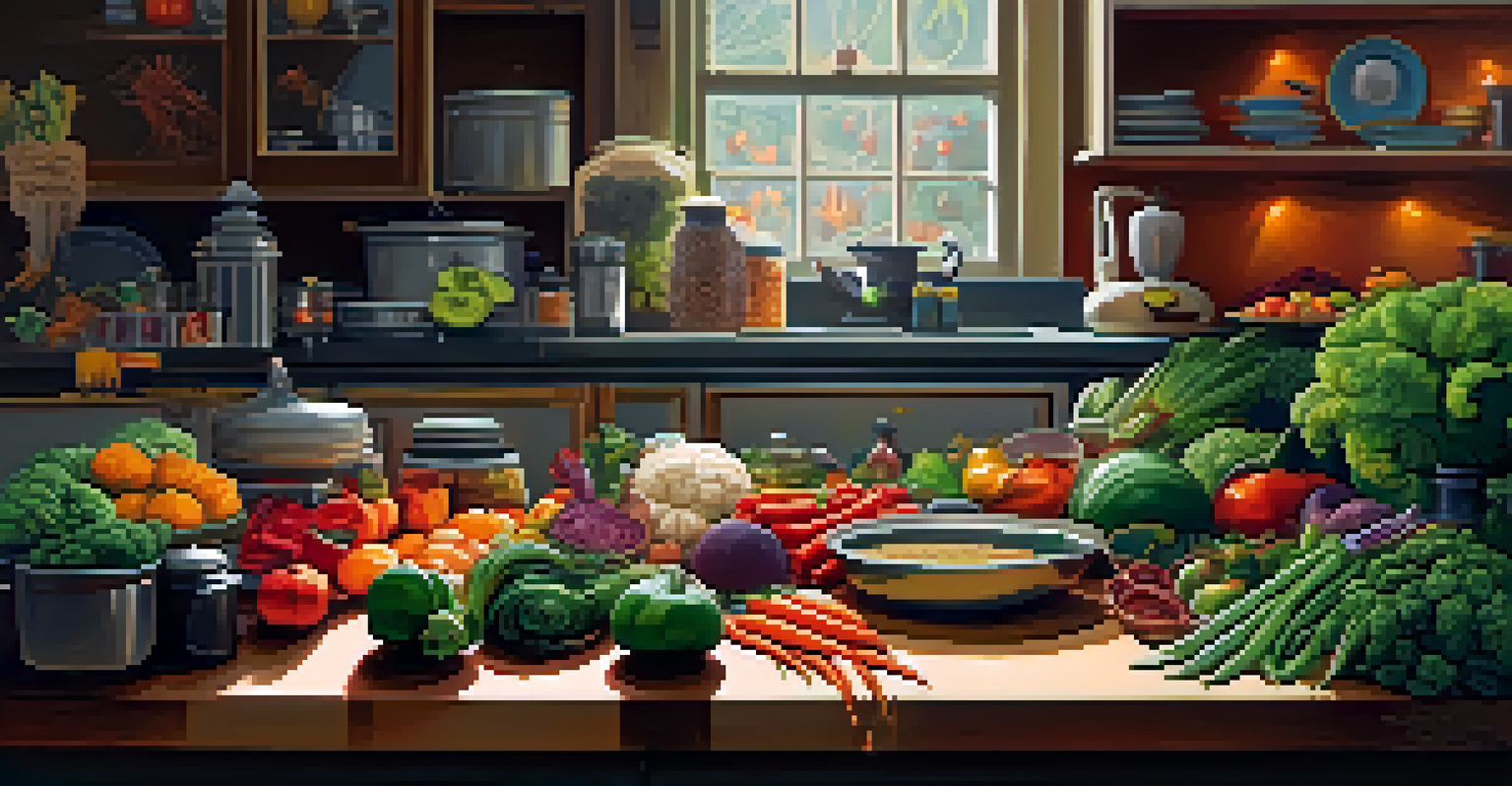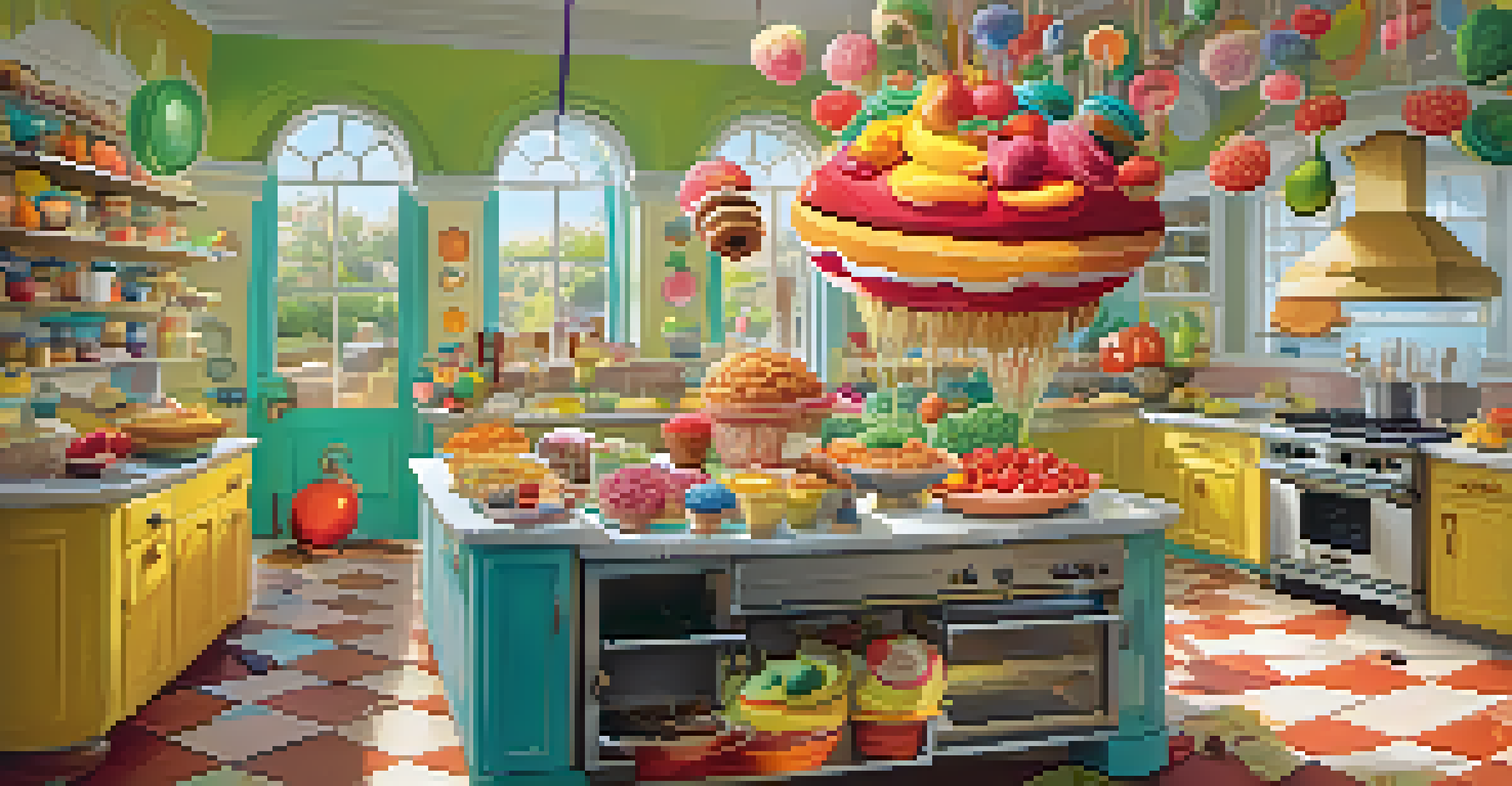Film Genres and Their Impact on Food Trends and Choices

The Connection Between Film and Food Culture
Film and food have always shared a unique bond, influencing each other in various ways. Movies often showcase food as a central theme, portraying cultural dishes that pique our interest and appetite. As viewers connect with the characters and settings, they may feel inspired to try the foods seen on screen, leading to a surge in culinary curiosity.
Food is our common ground, a universal experience.
For instance, films like 'Julie & Julia' not only celebrate the art of cooking but also inspire audiences to explore French cuisine. The emotional connections formed through food in films can create cravings that often lead to real-life culinary adventures. This relationship highlights how cinema can shape our food preferences and inspire new trends.
Moreover, the portrayal of food in films often reflects societal values and trends, making it a fascinating lens through which to examine culinary evolution. As we watch, we not only see meals but also cultural practices and traditions that may prompt us to incorporate those elements into our own lives.
Romantic Comedies and Comfort Food Choices
Romantic comedies often feature comforting food choices that resonate with the audience's desire for familiarity and warmth. Think about iconic scenes where characters share a pizza or indulge in chocolate desserts during pivotal moments. These food choices not only enhance the romantic narrative but also evoke feelings of nostalgia and comfort.

By showcasing relatable meals, romantic comedies encourage viewers to embrace comfort food during their own romantic endeavors. As a result, we often see an uptick in popularity for these simple yet satisfying dishes, reinforcing the idea that food is integral to creating memorable experiences. It’s no wonder that a cozy night in often includes a favorite film and a comforting meal.
Film Shapes Food Trends
Movies influence culinary preferences and inspire viewers to explore new dishes and flavors showcased on screen.
Furthermore, the shared experience of watching a romantic comedy can lead friends and couples to recreate these culinary moments in their own kitchens. This cyclical influence highlights how film can directly impact food trends, fostering a sense of connection through shared meals inspired by cinematic love stories.
Horror Films and Adventurous Food Trends
Horror films often push the boundaries of food, challenging viewers to confront their culinary comfort zones. With gruesome scenes that feature bizarre food choices, these films can spark curiosity and inspire adventurous eating. For instance, watching a character devour unusual dishes can pique interest in trying new flavors or cuisines that one might not have considered otherwise.
The cinema is the ultimate vehicle for ideas and stories, and food is the ultimate vehicle for experiences and emotions.
This influence can lead to a rise in popularity for exotic foods, as viewers seek to replicate the experiences depicted on screen. The thrill of horror can translate into culinary exploration, encouraging us to step outside our comfort zone and try something daring. It's a fascinating way that film can propel food trends into the mainstream.
Moreover, horror-themed dining experiences, like pop-up restaurants or themed menus, capitalize on this adventurous spirit. They invite fans to engage with their favorite films in a tangible way, merging culinary and cinematic experiences into one thrilling night out.
Documentaries and the Rise of Healthy Eating Trends
Documentaries have a powerful impact on food trends, often shining a light on health and sustainability issues. Films like 'Forks Over Knives' and 'What the Health' have sparked conversations about plant-based diets and the benefits of mindful eating. By presenting compelling narratives and research, these documentaries encourage viewers to reconsider their food choices.
As audiences become more aware of the implications of their dietary habits, there is a noticeable shift towards healthier options. This can lead to an increase in the availability of organic produce, plant-based products, and sustainable food practices. The influence of documentaries extends beyond just awareness; it can actively reshape consumer behavior and preferences.
Culinary Arts Inspire Creativity
Culinary films reignite interest in cooking, prompting audiences to experiment with gourmet recipes and appreciate the artistry behind food preparation.
Additionally, the rise of social media allows these messages to spread further, with viewers sharing their own experiences and recipes inspired by the documentaries. This interconnectedness creates a community around healthy eating, fostering trends that prioritize well-being and environmental sustainability.
Action Films and Fast Food Culture
Action films often embody a fast-paced lifestyle, and this is mirrored in the food choices characters make. High-energy scenes paired with quick bites, like burgers or takeout, portray a sense of urgency and convenience. This reflection of lifestyle choices can influence audience preferences for fast food options in real life.
As viewers identify with the characters' need for quick sustenance amidst their adventures, fast food chains may see a rise in sales. The portrayal of food in action scenes also capitalizes on the thrill of the moment, making fast food synonymous with excitement and adventure. It’s a classic case of art imitating life, or vice versa.
Moreover, fast food marketing often ties in with action films, creating promotional campaigns that capitalize on this connection. This synergy between cinema and fast food can solidify trends that prioritize convenience, reflecting the busy lifestyles many lead today.
Animation and the Whimsical World of Food
Animated films bring a sense of wonder to food, often featuring imaginative dishes that captivate both children and adults. Movies like 'Ratatouille' and 'Cloudy with a Chance of Meatballs' not only entertain but also inspire creativity in the kitchen. These whimsical portrayals encourage audiences to think outside the box when it comes to their culinary creations.
The colorful and exaggerated food presentations in animated films can lead to a surge in interest for quirky recipes and themed food parties. Families may find themselves inspired to recreate the fanciful dishes they see on screen, bringing a sense of fun and adventure to mealtime. It's a delightful way that animation can transform how we view food.
Shared Meals Foster Connections
Films emphasize the joy of sharing meals, encouraging viewers to recreate cinematic culinary moments and strengthen bonds with loved ones.
Additionally, animated films often emphasize the joy of sharing meals, which can foster community and togetherness. This focus on food as a source of connection can impact food trends, encouraging families to explore new recipes and engage with each other through cooking.
Culinary Films and the Chef Revolution
Culinary films, such as 'Chef' and 'Burnt,' have sparked a resurgence of interest in the culinary arts. These films celebrate the passion and creativity of chefs, inspiring viewers to appreciate the intricacies of cooking. As a result, there has been a notable increase in culinary schools and cooking classes, as people seek to hone their skills.
The portrayal of food as an art form in these films encourages a trend towards gourmet cooking at home. Many viewers are motivated to try their hand at intricate recipes, experimenting with flavors and techniques they’ve seen on screen. This culinary revolution emphasizes the joy of cooking and the importance of quality ingredients.

Furthermore, the rise of food-centric reality shows has also played a role in this trend, blending entertainment with education. As audiences engage with these culinary narratives, they become more adventurous eaters, eager to explore new flavors and cooking methods that reflect the creativity celebrated in these films.